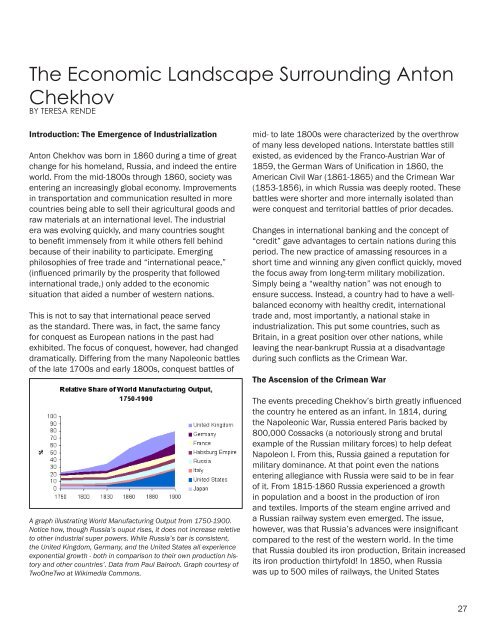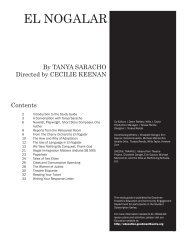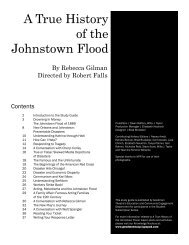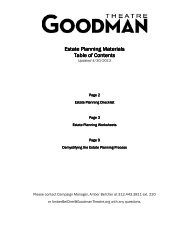The Seagull Study Guide (12MB) - Goodman Theatre
The Seagull Study Guide (12MB) - Goodman Theatre
The Seagull Study Guide (12MB) - Goodman Theatre
Create successful ePaper yourself
Turn your PDF publications into a flip-book with our unique Google optimized e-Paper software.
<strong>The</strong> Economic Landscape Surrounding Anton<br />
Chekhov<br />
BY TERESA RENDE<br />
Introduction: <strong>The</strong> Emergence of Industrialization<br />
Anton Chekhov was born in 1860 during a time of great<br />
change for his homeland, Russia, and indeed the entire<br />
world. From the mid-1800s through 1860, society was<br />
entering an increasingly global economy. Improvements<br />
in transportation and communication resulted in more<br />
countries being able to sell their agricultural goods and<br />
raw materials at an international level. <strong>The</strong> industrial<br />
era was evolving quickly, and many countries sought<br />
to benefit immensely from it while others fell behind<br />
because of their inability to participate. Emerging<br />
philosophies of free trade and “international peace,”<br />
(influenced primarily by the prosperity that followed<br />
international trade,) only added to the economic<br />
situation that aided a number of western nations.<br />
This is not to say that international peace served<br />
as the standard. <strong>The</strong>re was, in fact, the same fancy<br />
for conquest as European nations in the past had<br />
exhibited. <strong>The</strong> focus of conquest, however, had changed<br />
dramatically. Differing from the many Napoleonic battles<br />
of the late 1700s and early 1800s, conquest battles of<br />
A graph illustrating World Manufacturing Output from 1750-1900.<br />
Notice how, though Russia’s ouput rises, it does not increase reletive<br />
to other industrial super powers. While Russia’s bar is consistent,<br />
the United Kingdom, Germany, and the United States all experience<br />
exponential growth - both in comparison to their own production history<br />
and other countries’. Data from Paul Bairoch. Graph courtesy of<br />
TwoOneTwo at Wikimedia Commons.<br />
mid- to late 1800s were characterized by the overthrow<br />
of many less developed nations. Interstate battles still<br />
existed, as evidenced by the Franco-Austrian War of<br />
1859, the German Wars of Unification in 1860, the<br />
American Civil War (1861-1865) and the Crimean War<br />
(1853-1856), in which Russia was deeply rooted. <strong>The</strong>se<br />
battles were shorter and more internally isolated than<br />
were conquest and territorial battles of prior decades.<br />
Changes in international banking and the concept of<br />
“credit” gave advantages to certain nations during this<br />
period. <strong>The</strong> new practice of amassing resources in a<br />
short time and winning any given conflict quickly, moved<br />
the focus away from long-term military mobilization.<br />
Simply being a “wealthy nation” was not enough to<br />
ensure success. Instead, a country had to have a wellbalanced<br />
economy with healthy credit, international<br />
trade and, most importantly, a national stake in<br />
industrialization. This put some countries, such as<br />
Britain, in a great position over other nations, while<br />
leaving the near-bankrupt Russia at a disadvantage<br />
during such conflicts as the Crimean War.<br />
<strong>The</strong> Ascension of the Crimean War<br />
<strong>The</strong> events preceding Chekhov’s birth greatly influenced<br />
the country he entered as an infant. In 1814, during<br />
the Napoleonic War, Russia entered Paris backed by<br />
800,000 Cossacks (a notoriously strong and brutal<br />
example of the Russian military forces) to help defeat<br />
Napoleon I. From this, Russia gained a reputation for<br />
military dominance. At that point even the nations<br />
entering allegiance with Russia were said to be in fear<br />
of it. From 1815-1860 Russia experienced a growth<br />
in population and a boost in the production of iron<br />
and textiles. Imports of the steam engine arrived and<br />
a Russian railway system even emerged. <strong>The</strong> issue,<br />
however, was that Russia’s advances were insignificant<br />
compared to the rest of the western world. In the time<br />
that Russia doubled its iron production, Britain increased<br />
its iron production thirtyfold! In 1850, when Russia<br />
was up to 500 miles of railways, the United States<br />
27
















